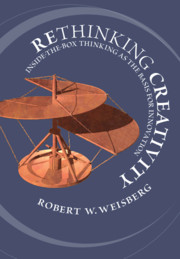Book contents
- Rethinking Creativity
- Rethinking Creativity
- Copyright page
- Dedication
- Contents
- Figures
- Tables
- Part I Introduction
- Part II Analytic Thinking in Creativity
- 3 Problem-Solving
- 4 Case Studies of Creativity
- 5 Analogical Thinking in Problem-Solving and Creativity
- Part III The Question of Extraordinary Thought Processes in Creativity
- Part IV The Psychometrics of Creativity
- Part V The Neuroscience of Creativity
- References
- Index
5 - Analogical Thinking in Problem-Solving and Creativity
from Part II - Analytic Thinking in Creativity
Published online by Cambridge University Press: 01 October 2020
- Rethinking Creativity
- Rethinking Creativity
- Copyright page
- Dedication
- Contents
- Figures
- Tables
- Part I Introduction
- Part II Analytic Thinking in Creativity
- 3 Problem-Solving
- 4 Case Studies of Creativity
- 5 Analogical Thinking in Problem-Solving and Creativity
- Part III The Question of Extraordinary Thought Processes in Creativity
- Part IV The Psychometrics of Creativity
- Part V The Neuroscience of Creativity
- References
- Index
Summary
In earlier chapters, we saw multiple examples of analogical thinking in creativity. The specific role of analogical thinking in creativity is the focus of Chapter 5. The chapter first reviews general aspects of analogical thinking, which leads to an examination of the mechanisms whereby analogical thinking plays a role in creativity. One such mechanism involves analogical transfer: the solution from a problem in memory is transferred to a new problem. A different use of analogical thinking in creativity occurs when a person has been working unsuccessfully on a problem and then puts it aside. The person then encounters an object in the world that is analogous to what is needed to solve the problem and provides an idea for solution. In this chapter, we will flesh out the details underlying use of analogies, including some situations in which analogical use is difficult.
Information
- Type
- Chapter
- Information
- Rethinking CreativityInside-the-Box Thinking as the Basis for Innovation, pp. 145 - 180Publisher: Cambridge University PressPrint publication year: 2020
Accessibility standard: Unknown
Why this information is here
This section outlines the accessibility features of this content - including support for screen readers, full keyboard navigation and high-contrast display options. This may not be relevant for you.Accessibility Information
- 1
- Cited by
